When it comes to the perfect way to plant and grow asparagus for years of incredibly delicious harvests – it’s hard to beat using the simple trench planting method. It makes planting and growing asparagus a breeze – all while helping to develop healthy, strong roots that can deliver mountains of fresh asparagus spears for years to come!
Unlike traditional garden crops such as cucumbers, peppers and tomatoes, asparagus is a perennial vegetable plant that comes back to produce year after year. In fact, once established, asparagus can produce fresh spears for up to twenty or more years!
Even better, not only is it simple to plant, asparagus is also an incredibly easy and low maintenance crop to maintain with each passing season. Especially when you plant using the trench method!
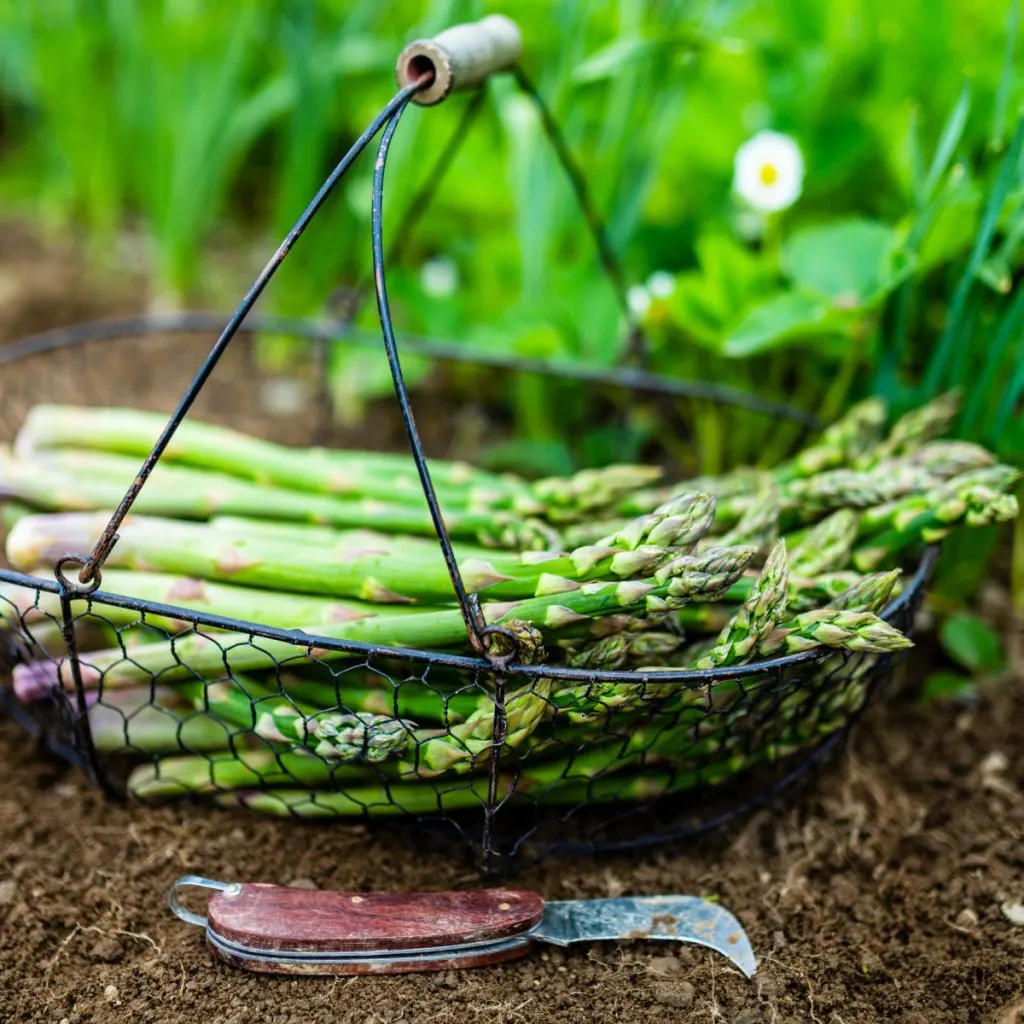
The Perfect Way To Plant Asparagus – The Simple Secrets To Success!
When planting asparagus, success all begins with planting crowns instead of seeds. Unfortunately, although seeds are certainly less expensive to start, growing from them can be an incredibly difficult and time consuming task.
Asparagus seeds are hard to germinate. And even when they do pop up, the tiny shoots are often mistaken for weeds. That can lead to gardeners pulling many of the tender shoots up as they try to keep their bed spaces clear of any competing weeds early on.
Adding to the frustration is that when growing from seed – it can be a long process to get to a harvest. In fact, it can take as long as 3+ years before edible spears form when growing from seed!
But perhaps the biggest detriment of all when starting asparagus from seed is that it can really be hard to get the roots of the plants to develop properly. And when it comes to growing great asparagus – the roots are one of the most important factors of all for just how well they will grow and produce long term.
Growing From Crowns – The Perfect Way To Plant Asparagus
So what are asparagus crowns and why are they better to plant? Crowns are actually the roots of 1 to 2 year-old asparagus plants – and they are by far the easiest method to plant – and the fastest way to grow harvestable spears.
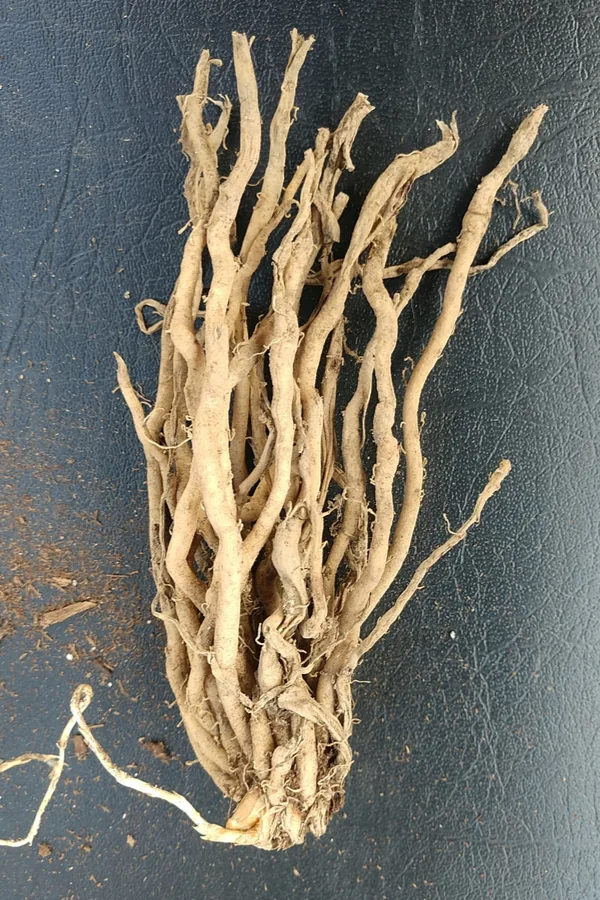
Asparagus crowns can begin to be harvested and enjoyed by the second growing season. In some cases, you might even be able to even harvest a single spear or two even in the first year.
But even better, crowns are also much easier to start and maintain than seeds. By the very fact they are older and larger, the first sprouts that shoot through the ground are more defined early on. Which, of course, results in a crop that’s easier to locate for watering, weeding and fertilizing.
Male Vs. Female Asparagus – The Perfect Way To Plant Asparagus
Another big difference with asparagus plants versus other vegetable plants is that they can either be male or female. Even though both can be harvested and consumed, there is a difference between the the two. And that difference can be important to know when purchasing crowns for planting.
Male varieties of asparagus tend to be larger and have more abundant spear production. Female varieties, on the other hand, tend to be smaller in both height and circumference. Because of the larger size and production levels, male varieties are usually the preferred planting choice for a home garden.
The good news is that you do not need to have a male and a female plant near each other for the plants to produce their spears. So if it’s just big tasty spears you are going for – male asparagus is the way to go.
Listen In Below To Our Podcast On Planting & Harvesting Asparagus!
If you, however, want happen to want your asparagus to produce seeds for creating more plants from seed, you will need to plant a few females plants. They are the only asparagus types that will produce berries and seeds.
How To Plant Asparagus Using The Trench Method – The Perfect Way To Plant Asparagus
The best time for planting asparagus is in the early spring or summer. This gives the crowns a full season to grow and develop. As for finding them for planting, many local greenhouses and garden centers will carry a selection of crowns.
You can also find a good selection of crowns on line (see below for links). The most important key when purchasing is to get your crowns early as they often sell out fast.
- JERSEY KNIGHT Asparagus Plants / bare-root crowns — Organic NON-GMO
- Purple Pacific 10 Live Asparagus Bare Root Plants
- Mary Washington Live Asparagus Bare Root Plants – 2yr Crowns – (25 Crowns)
How To Plant With The Trench Method
The trench method of planting works exactly as it sounds – you dig a trench in a row, or a row of trenches, and then plant the crowns down in the valley of the trench.
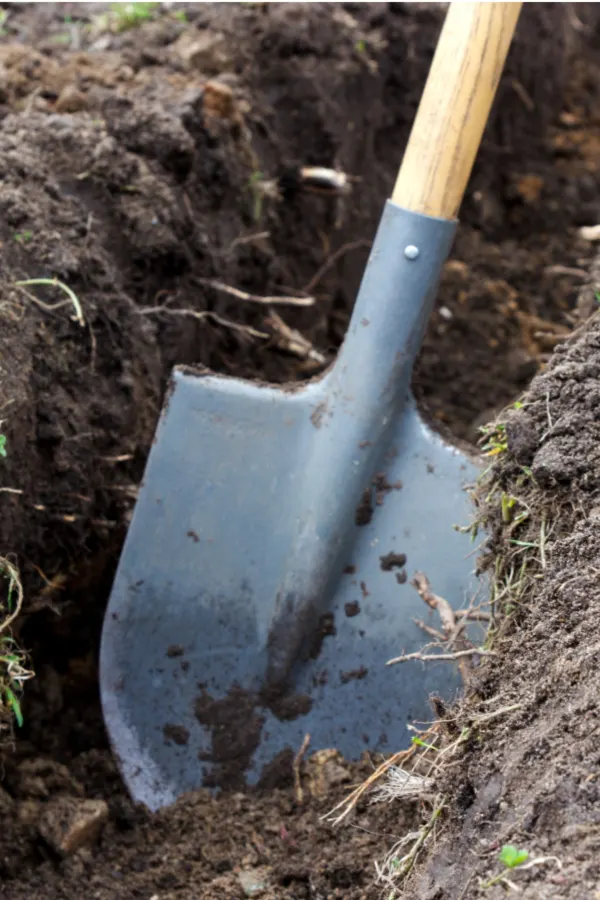
However, there is one slight difference when planting asparagus in a trench. Unlike most other plants or crops, you will not want to fill in the entire trench after planting. Instead, you spread out the asparagus crows in the bottom of the trench and only fill it partially up to barely cover them.
As you will see in a moment, this is the perfect way to develop strong roots and a great future asparagus harvest!
Creating The Trench – The Perfect Way To Plant Asparagus
Start by digging a trench 6 inches deep and 8 inches wide in the soil. You will need to allow about 18 inches between crowns and 12 inches between each row when planting. Use this spacing to help determine how long and how many trenches you will need.
It does not matter if you have one long row or multiple shorter rows as long you leave enough space between each crown. They do not need any type of cross pollination to create their spears.
One thing is for sure when planting asparagus, with a long crop cycle of 20 or more years, it’s important to prepare each trench with extra nutrients. Although you can fertilize and add nutrients in future years, giving the crowns a rich, well-draining soil from the start is a big key to lasting success.
The best way to enrich an asparagus trench before planting is with compost. For each crown you will be planting, add in a few shovels of compost to the portion of the trench where you will be placing your crown. See our article: How To Take Care Of A Compost Pile – 4 Secrets To Make Great Compost!
Be sure to mix the compost well with the soil to blend it all together. If your soil is extremely hard or clay-like, add in a few shovels of sand as well to help with drainage.
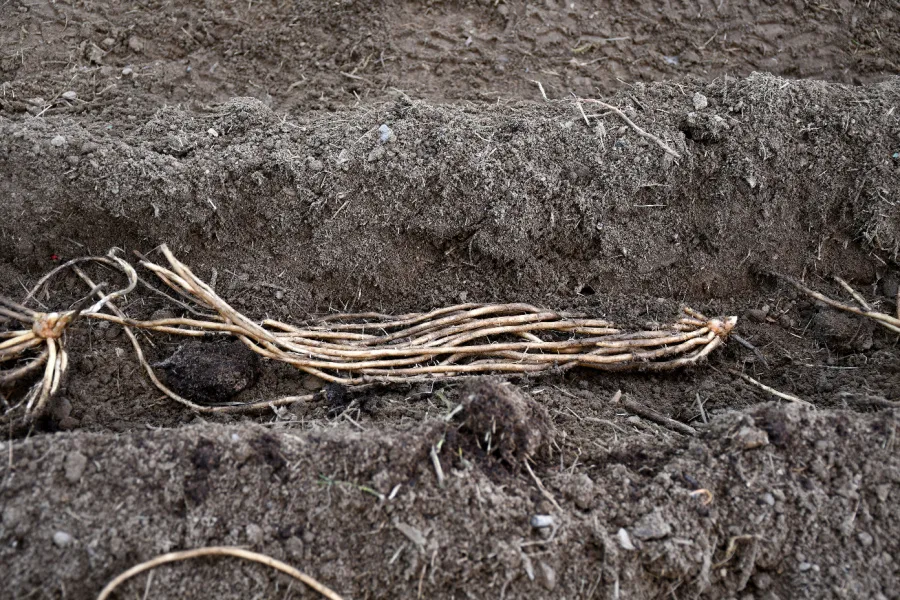
Planting The Crowns – The Perfect Way To Plant Asparagus
Now it’s time to plant! Place each crown at the bottom of the trench. Be careful to spread out the roots as you do. Water the crowns and then cover with about 2″ of soil. Do not fill in the rest of trench. Instead, you want to allow the crows to sprout and come through the lower depth of soil.
Depending on weather conditions, it may take a week or two for the crowns to sprout through the surface. As the crown begins to grow through the soil, keep adding a few inches of soil, filling in the trench slowly as it grows. Eventually, the trench will fill in completely over the course of a few weeks.
Maintaining The Crop – The Perfect Way To Plant & Grow Asparagus
The general rule-of-thumb is to not harvest any spears during the first year’s growth. Although some gardeners will harvest just a few, you are better off to let the energy develop to the roots. And by letting the plants grow all year, that is exactly what you will be doing.
The second year, you will be able to harvest a little more – but you still want to allow the roots to develop by not harvesting too much. In year two, harvest just two to three spears per plant over a two to three week period. Only harvest stalks larger than a pencil in thickness. Let all of the other smaller ones grow into ferns in order to power the next harvest.
When harvesting, cut the spears off with a sharp knife just below the soil line. You can snap off the spears as well, but it’s best to use a sharp knife instead. The knife helps in keeping a clean cutting end, and also helps in keeping the crowns safe from pulling up when harvesting.
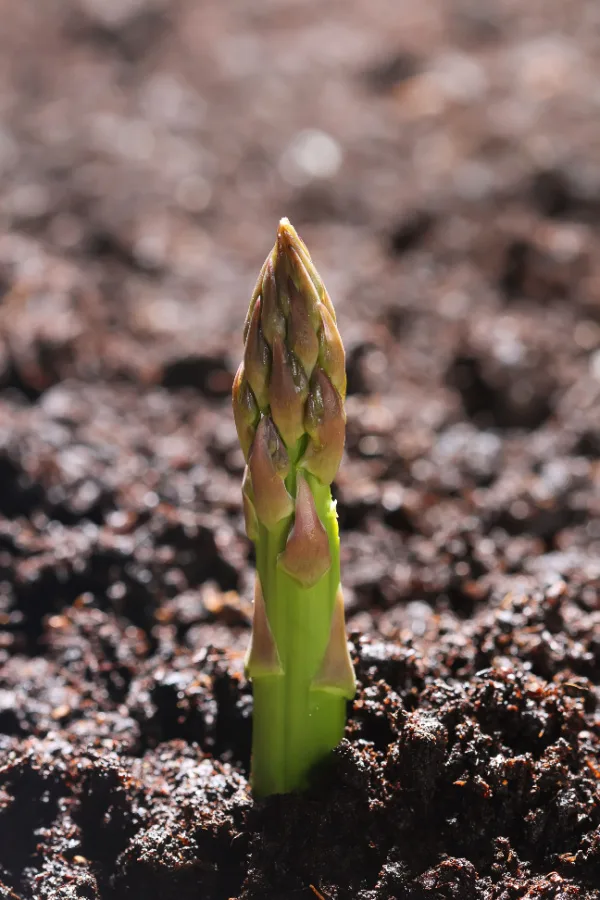
Every spring thereafter, harvest the spears that measure about 3/8″ in diameter and are at least 6 to 8 inches tall. The harvest after year two and beyond will usually last for four to eight weeks. Harvesting should end when most of the spears that are left are small and have their tips open.
Once harvesting is over, always let your plants grow at will for the remainder of the summer. This helps store energy in the crowns below for the following year’s spears. Once the plants have died back after frost, you can then cut them back.
Keys To Success – The Perfect Way To Plant & Grow Asparagus
The biggest key to growing asparagus successfully is to keep your beds weed free. Weeds and grass compete for valuable nutrients, and a weed-filled bed will result in smaller, less productive harvests.
Straw works great as a year round mulch to help keep weeds out and moisture in. To keep beds productive, add an inch or two of compost as a top dressing each fall before mulching. Do this again in the spring before they begin to pop through the surface. This will be more than enough to fertilize and keep your plants powered up.
Here is to enjoying a long-lasting perennial harvest of asparagus in your home garden!
Follow Our Facebook Page For Even More Great Tips! Simple Garden Life Facebook Page
Simple Garden Life is a website dedicated to keeping gardening fun, simple and enjoyable! We publish two new articles each week along with a new garden podcast episode every two weeks. This article may contain affiliate links.
